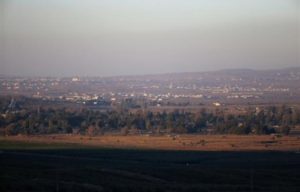
Now Media:
Hezbollah has allegedly started to “secretly” deploy its members to Quneitra to replace regime troops stationed in the province near the Golan demarcation line with Israel, according to a pro-opposition outlet.
Al-Etihad press reported Thursday that pro-regime troops in Madinat al-Baath and Khan Arnabeh—both government strongholds northeast of the rebel-held Quneitra border crossing—were being “withdrawn in batches” for redeployment near the western Ghouta suburbs of Damascus.
The outlet’s report mirrored that of local correspondent Omar al-Joulani, who reported on Tuesday that pro-regime forces as well as Hezbollah withdrew a number of their combatants and tanks from the two Quneitra province towns.
However, Al-Etihad press cited local sources as saying that Hezbollah members “came out with the regime forces in public,” but returned in secret to positions under the guise of being local militiamen.
“Hezbollah fighters… returned under the name of the Golan Regiment,” the sources claimed, in reference to the predominantly Druze force that fights under the banner of the regime’s auxiliary National Defense Force.
On Monday, Iran’s Fars News reported that Hezbollah and Syrian regime forces are readying a major offensive against rebels along the Golan demarcation line with Israel
Syrian military sources said that Hezbollah deployed fighters “in the vicinity of the Quneitra border crossing.”
“[Hezbollah] aims to put an end to the presence of armed men in the area close to the border,” the sources told the Iranian outlet.
The Fars News report comes after the leader of Iran’s paramilitary Basij force, General Mohammad Reza Naqdi, toured Syria’s border with Israel near Quneitra in July, the first such visit of a top-ranking official from Tehran to be publicized in Iranian media.
Cross-border incidents
In past weeks, pro-regime forces have bombarded rebel positions in Al-Hamidiyah and other rebel-held villages along the Golan border near the Quneitra crossing, with a number of mortar rounds hitting Israel, prompting Tel Aviv to launch retaliatory strikes on at least five occasions.
On July 4, the Israel Defense Forces (IDF) hit two Syrian army targets in the Golan after stray fire damaged the technical fence stretching across the demarcation line between the two countries in the mountainous region.
Two weeks later, an unmanned aerial vehicle crossed over the border into Israeli territory in the central Golan, prompting Israel to fire two Patriot missiles in an unsuccessful attempt to shoot down the drone.
An air-to-air missile fired by an Israeli jet also failed to bring down the drone, which Tel Aviv suspects is Russian-manufactured.
